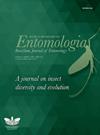Infection of perennial ryegrass (Lolium perenne) by an endophyte fungus (Neotyphodium lolii) decreases the abundance and diversity of predators and parasitoids
IF 1.3
4区 农林科学
Q4 ENTOMOLOGY
引用次数: 0
Abstract
(E) and Alto AR1 (E+). We observed an 80% endophyte infection rate for (E+) and 0% for (E). Moreover, 222 individual spiders corresponding to 10 families were identified in both perennial ryegrasses, including 209 individuals for (E) and 13 for (E+). The most abundant spider family was Lycosidae, representing 71.17% of the total spiders. In addition, 65 insects were collected, corresponding to 6 families, with Carabidae being the most abundant. Furthermore, the Simpson index indicated the dominance of the family Lycosidae. Overall, spider and insect abundance and diversity were reduced in (E+), suggesting a negative effect of the endophyte on predator populations.多年生黑麦草(Lolium perenne)被内生真菌(Neotyphodium lolii)侵染后,捕食者和拟寄生物的丰度和多样性降低
本文章由计算机程序翻译,如有差异,请以英文原文为准。
求助全文
约1分钟内获得全文
求助全文
来源期刊
CiteScore
1.50
自引率
12.50%
发文量
14
审稿时长
6-12 weeks
期刊介绍:
Information not localized

 求助内容:
求助内容: 应助结果提醒方式:
应助结果提醒方式:


